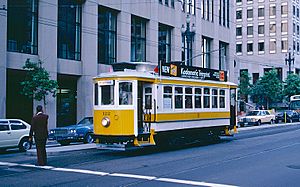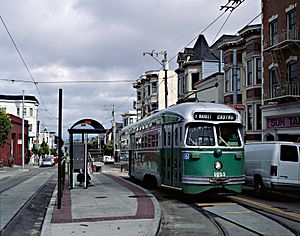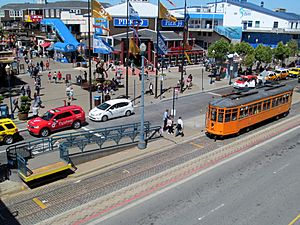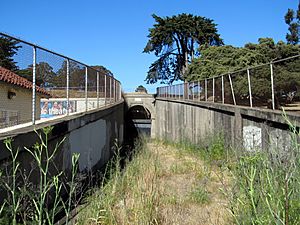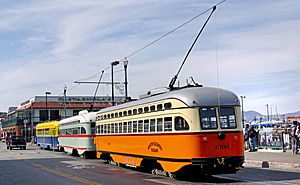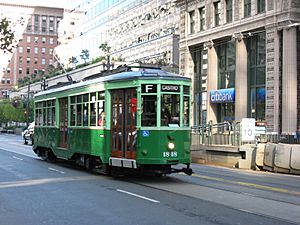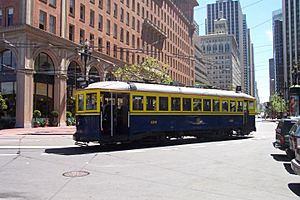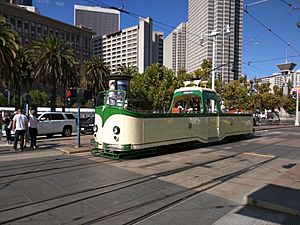- This page was last modified on 17 October 2025, at 10:18. Suggest an edit.
F Market & Wharves facts for kids
| F Market & Wharves | |
|---|---|
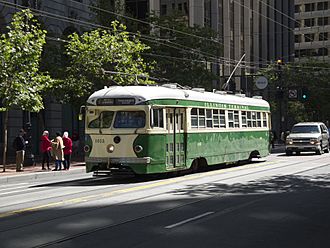
Car 1015, one of San Francisco's original double-ended PCC streetcars, on Market Street near the Ferry Building, painted in the colors of the Illinois Terminal Railroad (St. Louis)
|
|
| Overview | |
| Owner | San Francisco Municipal Transportation Agency |
| Locale | San Francisco, California |
| Termini |
17th Street and Castro |
| Stations | 32 |
| Service | |
| Type | Heritage streetcar |
| System | San Francisco Municipal Railway |
| Operator(s) | San Francisco Municipal Railway |
| Rolling stock | PCC streetcars; other historic streetcars |
| Daily ridership | 23,208 (2013) |
| History | |
| Opened | 1983–1987 (Trolley Festivals) September 1, 1995 (revenue service) |
| Technical | |
| Line length | 6 mi (9.7 km) |
| Character | At grade, street running |
| Track gauge | 4 ft 8 1⁄2 in or 1,435 mm standard gauge |
| Electrification | Overhead lines, 600 V DC |
The F Market & Wharves line is a special light rail line in San Francisco, California. Unlike most other train lines, the F line uses old, historic streetcars. These streetcars come from San Francisco's past and from cities all over the world. Sometimes, buses are used during busy times.
The F line is run by the San Francisco Municipal Railway (Muni). A group called Market Street Railway helps keep it going. This group loves streetcars. They raise money and help fix up the old cars.
The F line started in 1983 as the F Market. It was part of the first San Francisco Historic Trolley Festival. It first ran between the Castro District and the Transbay Terminal. In 1995, it became a full-time service. In March 2000, the line was made longer. It now goes along the Embarcadero and up to Fisherman's Wharf. A small part of the old route was stopped.
Even though it uses old streetcars, the F Market & Wharves line is a very important part of San Francisco's public transport. It runs often, about 20 hours a day, seven days a week. It helps both local people and tourists get around. It connects homes, businesses, and fun places in the city. Also, it uses the regular Muni fare, which is cheaper than the cable cars.
History of the F Line
What was the Old F-Line?
Cable cars started running on Market Street in 1888. Then, in 1906, they changed to electric streetcars.
In 1915, Muni started an F-Stockton route. This line ran from the Marina to Market Street. Later, it went to the Caltrain Depot. This streetcar line stopped running in 1951. It was replaced by the 30-Stockton bus route, which still runs today.
Because the old F-line was gone, the name "F-line" was free. So, the new historic streetcar line could use it. But remember, the new F-line goes on a totally different path!
Market Street's Past Trains
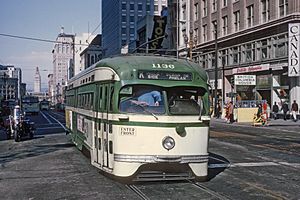
A PCC streetcar on the K Ingleside route on Market Street in 1967
Market Street is a very important road for transport in San Francisco. It has had many types of trains over the years. First, there were horse-drawn streetcars. Then came cable cars and electric streetcars.
In the 1960s, work began on the Market Street subway. This underground tunnel would carry BART trains on its lower level. All the streetcar lines that now run in the subway used to run on the surface of Market Street. They were later moved into the upper level of the tunnel. This change, along with new light rail cars, created today's Muni Metro system.
By November 1982, the streetcar lines on Market Street were moved into the tunnel. The old streetcars were replaced with new light rail cars. But the old tracks on Market Street were kept. Many of the old streetcars were also still stored away.
Fun Trolley Festivals
In 1982, San Francisco's cable car lines closed for almost two years. They needed big repairs. To help, temporary historic streetcar service started on weekends in July 1982. It ran until September.
To give tourists something fun to see, the San Francisco Historic Trolley Festivals began in 1983. These summer events ran old streetcars on Market Street. It was a project by the San Francisco Chamber of Commerce and Muni.
The festival route went from the Transbay Terminal to Market Street. Then it went up the old Market Street tracks to Duboce Avenue. From there, it followed a special detour built in the 1970s. This detour went around the subway construction.
The F-Market Line is Born
The Trolley Festival was very popular. So, it happened every year until 1987. That year, plans began for a permanent F line. After the 1987 festival, Muni replaced the old Market Street tracks with new ones. They also put tracks back on upper Market Street, creating a line to Castro.
They looked at different types of old streetcars for the F-line. They decided to use the PCC streetcar. This was partly because PCC cars had been used in San Francisco before. Fourteen of these cars were bought from Philadelphia. Three of Muni's own old PCC cars were also used.
On September 1, 1995, the F line officially opened with a parade of PCC cars. Each car was painted to look like streetcars from different North American cities. More people rode the F line than expected. The 8-Market bus line was completely stopped on December 29, 1995. This was rare because a streetcar replaced a bus line, not the other way around! More cars were needed. So, ten Peter Witt-style cars were bought from Milan, Italy. These cars were built in the 1920s.
Extending to the Embarcadero
The Embarcadero is the eastern waterfront road in San Francisco. It runs along San Francisco Bay. It used to be busy with port and ferry traffic. But it became less used when cargo moved to Oakland. Also, the Bay Bridge replaced the ferries.
In the 1960s, the elevated Embarcadero Freeway was built above it. This road separated the city from the bay. But it was taken down after the 1989 Loma Prieta earthquake. People started suggesting streetcar service along The Embarcadero as early as 1974. Historic streetcars first ran there during the 1987 Trolley Festival. They used old tracks and generators for power.
The waterfront area started to become popular for fun and tourism. Fisherman's Wharf and Pier 39 are at its northern end. So, it was decided to rebuild the Embarcadero. It would become a tree-lined street with a special area for streetcars. The F line would be extended to serve the northern part of Market Street.
Tracks were extended to connect with the Embarcadero tracks. On March 4, 2000, the F line started running along the new extension to Fisherman's Wharf. It replaced bus route 32. The short part of the F line between Market Street and the Transbay Terminal was stopped. The last trip left the Transbay Terminal on March 3. The tracks were removed in August 2000.
A month after the extension opened, Muni named a streetcar after Herb Caen. He was a famous writer for the San Francisco Chronicle newspaper. He was known for calling San Francisco "Baghdad by the Bay." Streetcar No. 130 was built in 1914. It has wood panels and quotes from Herb Caen.
Making Market Street Better
The "Better Market Street" project started in the late 2000s. Its goal is to make Market Street better. Part of the project aims to improve how the F Line runs. This project would combine or remove some stops on Market Street. It would also build a new loop for the F Line at McAllister and 7th Streets.
This new loop would allow more streetcars to run between Fisherman's Wharf and the Civic Center. This part of the line has the most riders. With these improvements, streetcars would come every 5 minutes instead of every 7.5 minutes. The project was planned to start construction in 2020.
Future Plans: An Extension?
In December 2004, Muni studied extending the F-Line. This study was done with the National Park Service. The extended line would go west past the San Francisco Maritime Museum. Then it would go through the old (1914) but unused Fort Mason Tunnel. This tunnel used to belong to the State Belt Railroad.
A study about the environmental impact started in May 2006. It looked at different plans. The final plan was released in February 2012. This plan said that areas west of the Fort Mason Tunnel did not have enough public transport. It also said there were problems with the Fort Mason Center's transport.
The best plan was to have two tracks along Beach Street. Then, it would turn north to Aquatic Park. After that, it would cross Van Ness Avenue. Then, it would use a single track through a fixed-up Fort Mason Tunnel. It would end in the Fort Mason Center parking lot.
The F Line's Cool Cars
Muni has many different types of cars for the F line. But not all of them run at the same time. The cars are from four main groups: PCC streetcars, Peter Witt streetcars, older San Francisco streetcars, and 10 streetcars from other countries.
The F line mostly uses PCC and Peter Witt cars. But sometimes, other unique or very old cars are used. This includes cars 913 and 952, which are famous streetcars from New Orleans. The modern light rail cars used by Muni Metro cannot run on the F Market & Wharves tracks. This is because their power system is different.
PCC Streetcars
The F line uses PCC streetcars built between 1946 and 1948. These cars come from San Francisco, Philadelphia, and Newark. As of August 2007, Muni had 27 of these cars fixed up and running. Three of them are original San Francisco PCC cars. Sixteen cars came from SEPTA in Philadelphia in 1992. The other 11 cars came from New Jersey Transit in Newark in 2002.
Muni also has 30 more PCC cars that are not fixed up yet. Many of the restored cars are painted in the colors of other cities that used PCC streetcars. This includes Muni's own old colors.
Peter Witt Streetcars
Muni also uses Peter Witt streetcars on the F line. These cars were bought from Milan, Italy. There are 11 of them, all built in 1928. This design was common in many US cities, but never in San Francisco before.
Most of San Francisco's Peter Witt cars are orange, like they were in Milan. But one has been repainted to its original yellow and white. Another is green, like they were from the 1930s to the 1970s.
San Francisco's Oldest Cars
The F-Line also has very old streetcars built between 1895 and 1924. These cars were made for use in San Francisco. Three passenger cars were built for Muni. Two more were for the Market Street Railway Company, which was a competing company. Muni bought them in 1944. There is also a work car built in 1916. It was used to carry rails and other materials.
These old cars are painted in different colors from San Francisco's past streetcar lines.
Streetcars from Around the World
The F-Line has a cool collection of 10 streetcars from different countries:
- Blackpool tramway, in Blackpool, England (including two unique open-air "boat cars")
- The old Hamburg tram system, in Hamburg, Germany
- Hankai Tramway, in Osaka, Japan
- Kobe Municipal Transportation Bureau & Hiroshima Electric Railway, in Kobe & Hiroshima, Japan
- Melbourne & Metropolitan Tramways Board, in Melbourne, Australia
- Moscow tram system, in Moscow, Russia
- Porto tram system, in Porto, Portugal
- STIB/MIVB, in Brussels, Belgium.
All these cars are painted in the colors they used to have in their home countries. The only exception is the Brussels car. It is painted to honor San Francisco's sister city, Zürich in Switzerland. The Moscow trams had to have their wheels changed to fit San Francisco's tracks.
F Market & Wharves Stops
| Stop | Neighborhood | Connections |
|---|---|---|
| Jones and Beach | Fisherman's Wharf | Start of the line |
| Jefferson and Taylor | Inbound only | |
| Beach and Mason | Outbound only, Muni buses, Cable Car | |
| Jefferson and Powell | Inbound only, Ferries, Muni buses | |
| Beach and Stockton | Outbound only, Golden Gate Transit buses | |
| The Embarcadero and Stockton | Inbound only, Muni buses, serves Pier 39 | |
|
|
||
| The Embarcadero and Bay | Golden Gate Transit buses | |
| The Embarcadero and Sansome | ||
| The Embarcadero and Greenwich | ||
| The Embarcadero and Green | ||
| The Embarcadero and Broadway | ||
| The Embarcadero and Washington | ||
| Ferry Building | Financial District | Ferries, SolTrans buses |
| Don Chee Way and Steuart | Muni buses | |
| Market and Main (inbound) Market and Drumm (outbound) |
Above Embarcadero station (BART, Muni Metro), Muni buses, Golden Gate Transit, SamTrans, Cable Car | |
| Market and 1st Street (inbound) Market and Battery (outbound) |
Muni buses, Golden Gate Transit, SamTrans | |
| Market and 2nd Street (inbound) Market and New Montgomery (outbound) |
Above Montgomery Street station (BART, Muni Metro), Muni buses, Golden Gate Transit, SamTrans | |
| Market and 3rd Street (inbound) Market and Kearny (outbound) |
Muni buses, Golden Gate Transit, SamTrans | |
| Market and 4th Street (inbound) Market and Stockton (outbound) |
Above Powell Street station (BART, Muni Metro), Muni buses, Golden Gate Transit, SamTrans | |
| Market and 5th Street | Above Powell Street station (BART, Muni Metro), Muni buses, Golden Gate Transit, SamTrans | |
| Market and 6th Street (inbound) Market and Taylor (outbound) |
Civic Center / Tenderloin | Muni buses, Golden Gate Transit, SamTrans |
| Market and 7th Street | Inbound only, Above Civic Center/UN Plaza station (BART, Muni Metro), Muni buses, Golden Gate Transit, SamTrans | |
| Market and 8th Street (inbound) Market and Hyde (outbound) |
Above Civic Center/UN Plaza station (BART, Muni Metro), Muni buses, Golden Gate Transit, SamTrans | |
| Market and 9th Street (inbound) Market and Larkin (outbound) |
Muni buses | |
| Market and Van Ness | Above Van Ness station (Muni Metro), Muni buses | |
| Market and Gough | Hayes Valley | Muni buses |
| Market and Guerrero (inbound) Market and Laguna (outbound) |
||
| Market and Dolores (inbound) Market and Buchanan (outbound) |
Duboce Triangle | |
| Market and Church | Above Church station (Muni Metro), Muni buses | |
| Market and Sanchez | The Castro | Muni buses |
| Market and Noe | Muni buses | |
| 17th Street and Castro | Above Castro station (Muni Metro), Muni buses | |
See also
 In Spanish: F Market & Wharves para niños
In Spanish: F Market & Wharves para niños

